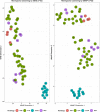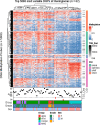Epigenetic and genomic profiling of chordoid meningioma: implications for clinical management
- PMID: 35440040
- PMCID: PMC9020042
- DOI: 10.1186/s40478-022-01362-3
Epigenetic and genomic profiling of chordoid meningioma: implications for clinical management
Abstract
Chordoid meningioma is a morphological variant of meningioma designated as WHO grade 2. However, the recurrence rates varied widely in different case series, and to date, a unifying molecular genetic signature has not been identified. Among 1897 meningiomas resected at our institution, we identified 12 primary chordoid meningiomas from 12 patients. Histologically, all 12 cases had predominant (> 50%) chordoid morphology. Ten were otherwise grade 1, and two were also atypical. We performed DNA global methylation profile, copy number variation analysis, and targeted next-generation sequencing on 11 chordoid meningiomas, and compared to those of 51 non-chordoid, mostly high grade meningiomas. The chordoid meningiomas demonstrated a unique methylation profile in tSNE, UMAP, and hierarchical heatmap clustering analyses of the most differentially methylated CpGs. The most common copy number variation in chordoid meningioma was loss of 1p (7/11, 64%). Three chordoid meningiomas had 2p loss, which was significantly higher than the non-chordoid control cohort (27% vs 7.2%, p = 0.035). 22q loss was only seen in the two cases with additional atypical histological features. Chordoid meningiomas were enriched in mutations in chromatin remodeling genes EP400 (8/11,73%) KMT2C (4/11, 36%) and KMT2D (4/11, 36%), and showed low or absent NF2, TERT, SMO, and AKT1 mutations. Prognosis wise, only one case recurred. This case had atypical histology and high-grade molecular features including truncating NF2 mutation, 1p, 8p, 10, 14, 22q loss, and homozygous deletion of CDKN2A/B. Progression free survival of chordoid, otherwise grade 1 meningioma was comparable to non-chordoid WHO grade 1 meningioma (p = 0.75), and significantly better than chordoid WHO grade 2 meningioma (p = 0.019). Conclusion: the chordoid histology alone may not justify a universal WHO grade 2 designation. Screening for additional atypical histological or molecular genetic features is recommended.
Keywords: Atypical meningioma; Brain tumor; Chordoid meningioma; Global methylation profile; Prognosis; WHO grade.
© 2022. The Author(s).
Conflict of interest statement
The authors declare that they have no competing interests.
Figures





References
MeSH terms
LinkOut - more resources
Full Text Sources
Molecular Biology Databases
Miscellaneous

